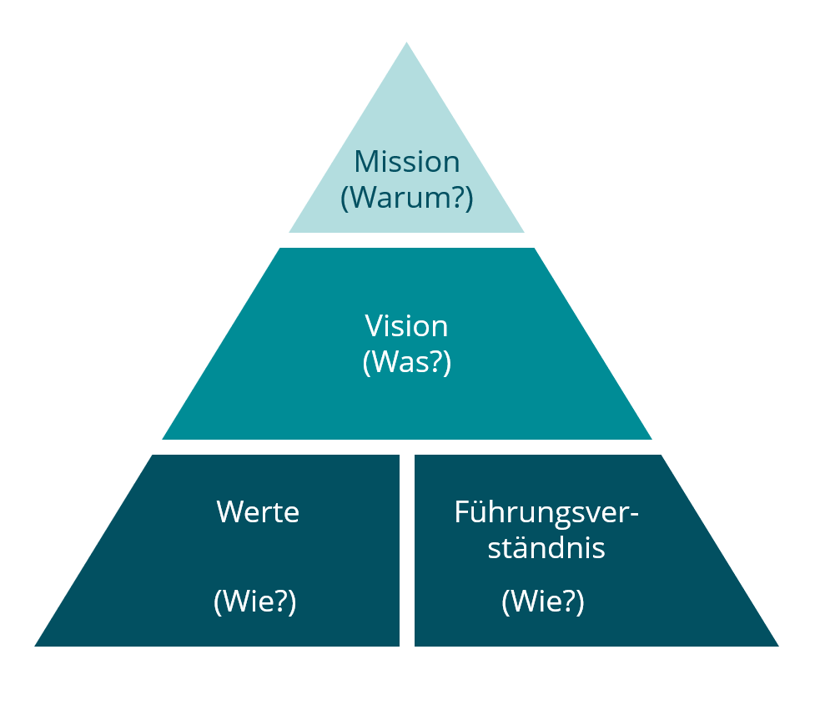Mission statement for companies: Definition, procedure & example
An organisation's self-image, purpose and values are set out in writing in a mission statement. Mission statements can be found everywhere - in companies, public administration, NGOs and sometimes even in the private sphere. They describe the goals of an organisation (the "WHAT"). At the same time, they also define the way in which the institution and the people working there should ideally achieve these goals (the "HOW").
Mission statements usually contain both clarifying and emotionalising elements. They often harbour a certain pathos that fills those involved with pride and that outsiders sometimes acknowledge with a smile.
What many mission statements have in common is that they look wonderful on glossy paper, but have little to do with the reality of work in the respective institution. This can lead to indifference and cynicism and thus achieve the opposite of what a good mission statement is supposed to achieve: To create clarity that guides action. It helps to think in advance about how the mission statement can be put into practice and become effective there.
This article shows which elements mission statements consist of, how they are typically developed and which success factors contribute to them actually being "lived" in the respective organisation.
Elements of a mission statement
At its core, a mission statement contains the mission or purpose of the organisation. From this, an overarching vision, values as guiding principles for action and a general understanding of leadership can be derived.

Mission/Purpose - the "why" in the mission statement
The mission or purpose (both terms are used synonymously) stands for the "WHY". It is the guiding principle for all actions and therefore represents the "top" of the mission statement. All other elements are derived from it. The mission is important for the external impact. Because as Simon Sinek explained in his TED Talk "Start with WHY" emphasises, people buy less the WHAT of a product and more the WHY of a service provider or an institution.
At the same time, the purpose serves as an identification tool for employees. People will not work successfully in the long term for an institution whose purpose is alien to them. Based on the purpose, they understand why they do their work in a certain way and thus remain motivated to work for the organisation in the long term. Ideally, the mission of an organisation should be directed both internally and externally so that it convinces (potential) employees as well as customers, suppliers and society.
For this to succeed, it is important to clearly outline the purpose of the organisation: What is our mission for our customers? What do we do for society? How do we make people's lives better, faster and less complicated? How do we create joy for our stakeholders in a way that no one else can?
The clearer the mission or purpose is worked out, the better. This is easier said than done, as stakeholders often have very different expectations of the organisation. It is important to understand the stakeholders as well as the intrinsic strengths and history of the organisation in order to formulate a mission that is equally inspiring, clear and desirable. The form can vary: Sometimes it is just a sentence, sometimes a longer text. In principle, however, the mission should not be equated with a "brand claim" or brand promise. This is because the latter is primarily communicated to the outside world and supports the company's marketing.
Vision - the "what" in the mission statement
Once the WHY has been clarified, the question of the WHAT arises: the vision resembles an inspiring idea of the future and answers the question of what the organisation wants to achieve in the long term. Such a vision can be formulated quantitatively and refer to a specific time period (e.g. 25 billion euros in sales by 2025 - "25-by-25") or describe a qualitative target state ("Crush our main competitor"). In any case, a purposefully formulated vision fulfils the following criteria for success:
- Clear and easy to understand for a broad target group
- Ambitious and arousing the sporting spirit of employees
- Emotionalising with a link to the company's mission and/or history
- Realistic so as not to create resignation
A mission can certainly last for longer periods of time. With visions, on the other hand, it is customary to review them from time to time - usually every three to five years - and to change or sharpen them if necessary. These adjustments are often accompanied by a change in the strategic direction of the organisation.
Values - the "how" in the mission statement
The direction in which it should go is now set. It consists of the WHY and the WHAT (mission and vision). In day-to-day business, strategic planning and budgeting processes are implemented on this basis. However, this does not yet clarify HOW implementation is to take place.
In a fictitious company that is by no means worthy of imitation, which relies on a purely mechanical, i.e. precisely defined control cascade and in which managers act as controllers, there is no need to define the HOW. It is already regulated by a detailed process specification.
In the real world, however, there are fortunately many degrees of freedom for managers and employees. Leadership, communication and collaboration in particular, as well as all tasks that involve weighing up alternatives and creative solutions, cannot be regulated down to the last detail. Rough guidelines are needed here to guide every employee in line with the mission/vision and thus facilitate decisions on action.
These guidelines are the corporate values (for all employees) and the understanding of leadership (for managers). They describe both how an organisation wants to behave towards the outside world and what internal ground rules for dealing with each other look like. Corporate values can be individual words or descriptions of specific behaviour. It is also possible to identify areas of tension using value pairs. The values can either address the company as a whole and be written in the "we" form (e.g. "We will not rest until our customers are satisfied - whatever the cost"). If, on the other hand, they are focussed on the individual employee, they are written in the "I" form (e.g. "I always go the extra mile for my customers"). Corporate values should be clearly orientated towards the mission and vision and not contradict them. They should be ambitious and desirable, but not so far removed from reality that they trigger cynicism among employees.
Corporate values apply to all employees. It must therefore be ensured that they are understood everywhere in terms of their "spirit" - whether in administration or operations. This often leads to values being formulated in rather general terms. Managers and employees must therefore work together to concretise them for their specific working reality.
Understanding leadership - the "how" in the mission statement
A key task of managers is to mediate between strategy and implementation. No matter how good the strategy and how talented and capable the employees may be, if managers fail to achieve impact through the way they lead, then the organisation will also fail to develop its full potential.
This is why an understanding of leadership is needed that describes the "HOW" of the leadership culture. It helps managers to translate the organisation's goals and make them tangible for their employees.
In principle, the mission statement also sets out specific behaviours. This can be done in different ways. The form of do's and don'ts is often chosen.
A universal understanding of "good" leadership performance does not exist. Depending on the company's history, cultural context, but also the current situation of the company, different leadership styles are required. The interesting question here is what is EFFECTIVE. This claim of effectiveness is typically derived from the mission, vision and strategy. For example, a company with an uninterrupted growth trajectory will require a different leadership style than an organisation that is currently undergoing restructuring.
When shaping the understanding of leadership, the following applies: if possible, do not stop at empty phrases (such as "we lead at eye level"), but be concrete and descriptive. If this is not possible, a subsequent discussion among the managers is always necessary in order to translate the formulated understanding of leadership into concrete behaviour depending on the context.
Develop and introduce a mission statement
Mission statements can have a guiding significance for organisations. On the one hand, they reflect elements of the respective culture that have evolved and, on the other, they explain the fundamental purpose, direction and mode of operation of the organisation.
Therefore, the development of a mission statement cannot be based purely on a bottom-up approach. A clear objective of the shareholders and/or management is required. An exclusively top-down approach, on the other hand, would also be counterproductive. This would make it difficult for employees to identify with the mission statement. A target-orientated approach therefore combines bottom-up and top-down elements and typically starts at board or management level.
These define initial guidelines based on examples from other institutions, but also by analysing the various stakeholder interests. This typically starts with the mission and vision. Building on this, those responsible then create initial drafts for the derived values and understanding of leadership.
In the next step, the subsequent management levels are involved, who then concretise and supplement the guidelines. Here, it is important to allow enough time for critical discussions, but also to set a clear timeframe by which a result should be achieved.
The elements of the guiding principles are certainly emotionally charged and, of course, there are also different tastes with regard to the linguistic style. It therefore helps to switch from the level of detail to the big picture and resolve potential conflicts by asking the question "What can you not live with?".
Depending on the type and size of the organisation, the mission statement is then approved by the management. In the next step, the mission statement is communicated to all top managers (usually top 100/-200), to whom it is presented in an emotionally charged town hall. The managers then reflect on the mission statement and apply it to their own business situation.
Finally, the managers are enabled to present the mission statement to the downstream levels and introduce it into the respective business context. In this context, it is important that there is a space in which employees can discuss the elements of the mission statement and the joint operationalisation within the team. In the spirit of: "What does this mean for us in our daily work?" This strengthens both the concretisation of and identification with the mission statement. At the same time, there is typically broad communication within the organisation.
Success factors for the introduction of a mission statement
Mission statements can take many forms - and vary greatly in the impact they achieve. The spectrum ranges from "turning point for the company" to "irrelevant marketing exercise". There are a few success factors to consider to ensure that the turnaround succeeds:
- Emotional communication: Fact-based communication is powerful and useful. But it only becomes fully effective when it is emotionalised - especially when it concerns major changes in direction. It is therefore important to communicate in an emotionally appealing way, e.g. using your own experiences, imagery, testimonials from board members, concrete examples of the mission statement or emotionally charged analogies in communication.
- Role model effect by top management: The management and the board must not only communicate the content of the mission statement, but also live it themselves. Otherwise, this can quickly lead to cynicism and resignation among employees ("If they don't do it up there, why should I?")
- Draw consequences (e.g. in HR instruments): If a mission statement has no consequences in the reality of the company, if behaviour remains without consequences (for better or for worse), then the belief in change among employees dwindles. It is therefore important to anchor the elements of the mission statement in processes and tools (e.g. HR tools). Examples include the importance of certain leadership behaviours for promotions or dismissals, the criteria for hiring, the rules according to which meetings are conducted and the introduction of 360° feedback.
- Show and celebrate successes: There are many small milestones on the way to the vision, which are reflected in the strategy, in the annual planning, but also in small local successes and projects. The aim here is to reap the rewards of the hard work and celebrate them in a way that attracts public attention.
- Ensure constant presence and relevance: Only when the mission statement is omnipresent will it be taken seriously. A three-month marketing campaign is not enough for this. It takes staying power to keep bringing the issues into the organisation. This also means that managers have to refer to the mission statement again and again so that it really becomes the "True North" guiding the organisation's actions.
- Facilitate dialogue and take feelings of disruption seriously: Mission statements are not always "polished" - sometimes they polarise, stimulate discussion, highlight conflicts of values and force a comparison with reality. These discussions are not always pleasant from the point of view of top management, but are nonetheless important. Dialogue (including critical dialogue) on the mission statement must be possible at all times (and institutionalised if necessary). Potential disruptive feelings from the team should be taken seriously and weighed up.
Whether and how the opportunity offered by such a concept is utilised depends not least on the managers. It depends on how honestly a company is interested in recognising itself as an organisation to reflect on itself as an organisation. And to what extent the people in this organisation are prepared to initiate conscious changes intelligently and then persevere with them.
Mission statement - an example from practice
A service company with around 10,000 employees was in the process of reinventing itself. The company's culture was extremely heterogeneous (due to various acquisitions in the past) and the current business model led to low customer satisfaction (despite high margins). In addition, they were about to be separated from the private equity funds that had previously owned them. With the change of CEO, the topic of a comprehensive transformation of the business model and thus the need for a mission statement finally came to the fore. The CEO told us at the time: "This company is very successful in the short term, but it has no soul. To create sustainable value for our various stakeholders, we need to change that."
We embarked on a joint journey that led to a mission statement that has endured to this day via various workshops in the Executive Board, at the next two management levels and cascaded communication right through to the employees. In addition to the usual intensive discussions about individual details in the mission, vision and values, the process also had a clarifying effect. For the first time, the organisation looked at its current and desired identity. This brought up topics that had never been discussed before, e.g: When in doubt, which stakeholder actually comes first for us? The customer or the shareholder? And are there exceptions to this rule?
Once the mission statement had been comprehensively discussed, adopted and also communicated emotionally within the company and to the outside world (CEO's quote to his top managers: "It's here to stay!"), it was important to stabilise it. To this end, regular reflections on the mission statement were incorporated into the teams' everyday work. In addition, the values and understanding of leadership were incorporated into the company's individual performance management. Furthermore, the understanding of leadership now served as a structure for 360° feedback for managers. The aim was to make the mission statement tangible in everyday life. This ultimately flanked the transformation of the company into a more sustainable and customer-centred business model.
Develop your mission statement
We hope that our mission statement article has given you some interesting ideas. We would be happy to support you and your company in developing your own mission statement and successfully bringing it to life. Please feel free to contact our mission statement experts Dr Florian Dressler or Dr Jens Müller-Oerlinghausen. We look forward to working with you to develop a solution for your specific challenges.





